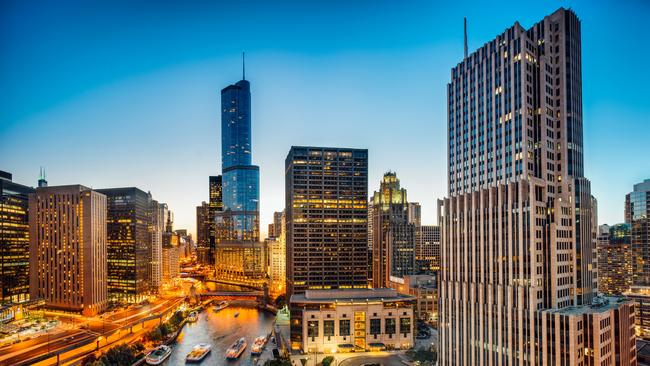There is no future for buildings that are not green, says JLL boss Christian Ulbrich
JLL global chief Christian Ulbrich has hit the ground in Sydney, telling the sector green buildings are in demand and property owners that don’t pivot are sitting on melting icebergs.

Global property markets are headed into a “new normal” where the base for a recovery in office values is being established as large companies are again taking up space in the wake of the pandemic.
The global chief executive and president of real estate agency JLL, Christian Ulbrich, says multinational corporations with operations around the world have worked out their needs and investors are getting back in the market.
His upbeat view comes with a caution that only the best green buildings will thrive in the coming period and markets still must face a workout of commercial real estate debt globally, which could lap up against Australian shores.
Mr Ulbrich, visiting Sydney from his base in Germany, said that his global outlook was positive, particularly when looking at the prospects of markets such as India, which he compared to China before its rapid industrialisation.
The crisis that swept through real estate during the pandemic had an even larger impact than the global financial crisis due to the big switch to working from home, combined with interest rates spikes, Mr Ulbrich said.
“Interest rates are where they are, and so prices have to adapt to the level of financing cost,” he said.
But corporations had come to terms with a “new baseline” for using offices, with cities such as Chicago having low attendance and Dallas almost full again, putting the US office sector into recovery.
“Two years post-Covid, corporates have nailed that baseline,” he said.
“And so we now know how much office space is needed. It is now starting to become a non-event whether it is working from home or not working from home because we have that baseline.”

But companies are demanding green buildings – although globally this yet to be fully appreciated.
“I think we are still at the early stages of people realising that there will be no future for buildings which are not green,” said Mr Ulbrich.
“I don’t think there’s a full realisation of property owners, when they own properties which are not really green, that they are sitting on a melting iceberg.”
With large tenants, especially corporations, imposing net zero targets, they are also chasing green buildings.
“So you either are able to turn your existing building into a green building, or you will face some challenges going forward because the value of your building compared to neighbouring green buildings will just kind of melt away,” he said.
Mr Ulbrich said the moves would be driven by large occupiers – which have their own targets on scope 3 emissions – that they would enforce on their providers.
“We are to some degree then, back to normality, but normality has been redefined,” he said.
He pointed to the growth in large cities, even in countries with low population growth, with top occupiers in global central business districts also growing faster than rivals. “That’s why the occupancy in the city centres of the large metropolitan areas continue to thrive,” he said.
Mr Ulbrich brings a global perspective to the emerging build-to-rent industry.
“In the US, nobody would call multifamily alternative; it is the largest asset class,” he said.
There was a shared global challenge in housing affordability for which there was “no easy solution”. But he cautioned against excessive regulation, which was “not necessarily helpful to grow the size of the pie” in housing.
“What that prevents is a lot of more product coming to market,” he said, with subsidies used in some markets also resulting in developments competing against each other.

But Ulbrich is optimistic that build-to-rent will significantly grow in Australia and commercial trades in the “living sector” could become more common.
He was cautious about debt markets, which were being driven by fast rising interest rates and lenders sitting on portfolios where actual loan to value ratios have become “uncomfortable”.
But attractive returns have lured a series of non-traditional lenders into the market, with up to 500 large lenders active in the US.
“There is liquidity in the market, but the liquidity is very expensive,” he said, noting that margins were also higher as demand was up.
“Overall, the cost of refinancing, if you want to invest into real estate, is much, much more expensive and complicated than it was before.” Debt pressures are global.
“At some point, it may come to Australia,” Mr Ulbrich said, likening them to a wave building up on the Pacific coast off California.
“The force of that wave may have kind of diminished, so it may not be as strong an impact on Australia as it is currently in the US.
But you will still feel that wave.”
Any bumps are likely to be offset by country level growth in emerging markets such as India, where Mr Ulbrich sees the potential for massive growth over the next two decades.
But he also sees opportunities in the US where, during an election year, the economy is growing at more than 3 per cent – and he sees “massive” potential.
While the real estate industry has been hit by lower transaction volumes, he said outsourced services were in strong demand in the new environment.
“When corporates are expecting pressure on the income stream, they are looking for some offset and reducing the cost,” Mr Ulbrich said.
“In the US, we are now moving up again. “The US has been first to go down, now it’s first to come out.”





To join the conversation, please log in. Don't have an account? Register
Join the conversation, you are commenting as Logout